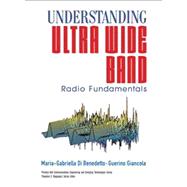
| Preface | |
| Approach | |
| Organization of the Book | |
| Audience and Course Use | |
| Web Site and Use of MATLAB | |
| Acknowledgments | |
| References | |
| Ultra Wide Band Radio Definition | |
| Fractional Bandwidth | |
| UWB vs. Non-UWB | |
| Further Reading | |
| References | |
| Appendix 1.A | |
| The UWB Radio Signal | |
| Generation of TH-UWB Signals | |
| Generation of DS-UWB Signals | |
| Generation of Multi-Band UWB Signals | |
| Further Reading | |
| References | |
| Appendix 2.A | |
| The PSD of TH-UWB Signals | |
| Borrowing from PPM | |
| The PPM-TH-UWB Case | |
| Further Reading | |
| References | |
| Appendix 3.A | |
| The PSD of DS-UWB Signals | |
| DS-UWB | |
| The Case of PAM-TH-UWB | |
| Further Reading | |
| References | |
| Appendix 4.A | |
| The PSD of MB-UWB Signals | |
| Spectral Characteristics of OFDM Signals | |
| The MB IEEE 802.15.TG3a Proposal | |
| Further Reading | |
| References | |
| Performance Analysis for the UWB Radio Link | |
| Power Limits and Emission Masks. What is included with this book? The New copy of this book will include any supplemental materials advertised. Please check the title of the book to determine if it should include any access cards, study guides, lab manuals, CDs, etc. The Used, Rental and eBook copies of this book are not guaranteed to include any supplemental materials. Typically, only the book itself is included. This is true even if the title states it includes any access cards, study guides, lab manuals, CDs, etc. ExcerptsThe last two years have witnessed an increased interest in both chip manufacturing companies and standardization bodies in Ultra Wide Band (UWB). Appealing features such as flexibility and robustness, as well as high-precision ranging capability, have polarized attention and made UWB an excellent candidate for a variety of applications. Given the strong power emission constraints imposed by the regulatory bodies in the United States, but likely to be adopted by other countries as well, UWB is emerging as a particularly appealing transmission technique for applications requiring either high bit rates over short ranges or low bit rates over medium-to-long ranges. The high bit rate/short range case includes Wireless Personal Area Networks (WPANs) for multimedia traffic, cable replacement such as wireless USB and DVI, and wearable devices, e.g., wireless Hi-Fi headphones. The low bit rate/medium-to-long range case applies to long-range sensor networks such as indoor/outdoor distributed surveillance systems, non-real-time data applications, e.g., e-mail and instant messaging, and in general all data transfers compatible with a transmission rate in the order of 1 Mb/s over several tens of meters. A recent release of the IEEE 802.15.4 standard for low rate WPANs (IEEE 802.15.4-2003, 2003) has increased attention towards the low bit rate case. The scenarios of applications mentioned above refer to networks that commonly adopt the self-organizing principle, that is, distributed networks. Examples of these networks are ad hoc and sensor networks, i.e. groups of wireless terminals located in a limited-size geographical area, communicating in an infrastructure-free fashion, and without any central coordinating unit or base-station. Communication routes may be formed by multiple hops to extend coverage. This paradigm can be viewed as different in nature from the cellular networking model where typically nodes communicate by establishing single-hop connections with a central coordinating unit serving as the interface between wireless nodes and the fixed wired infrastructure. The goal of this book is to help understanding UWB. But what is UWB? The general consensus establishes that a signal is UWB if its bandwidth is large with respect to the carrier or center frequency of the spectrum, that is, if its fractional bandwidth is high. The common adoption of the term UWB, which comes to us from the radar community, is compliant with this definition, and refers to electromagnetic waveforms with an instantaneous fractional bandwidth greater than about 0.200.25. These waveforms, because of their large bandwidth, must, at least in principle, friendly coexist with other Hertzian waveforms, which are present in the air interface. The coexistence principle introduces strong limitations over Power Spectral Densities (PSDs), and raises the issue of designing power efficient networks. Traditionally, UWB signals have been obtained by transmitting very short pulses, rather than continuous waveforms, with typically no Radio Frequencies modulation. This technique has been extensively used in radar applications and goes under the name of Impulse Radio (IR). Regarding wireless communications, the primal technique for transferring information over the radio medium was based, in fact, on the emission of pulsed signals. As described by (Sobol, 1984) in a milestone review paper, Marconi's first experiments, back in 18941896, used spark gap transmitters to transmit Morse Code messages over two miles, and Fessenden transmitted speech as early as in 1900 over one mile using a spark gap transmitter. Technological limitations and commercial pressure for reliable communications strongly favored, however, a shift of research and development towards continuous-wave transmissions, and IR remained relatively confined to the radar field up to recent years. The legacy of Marconi manifested from time to time: In 1946 a re
Rewards Program |